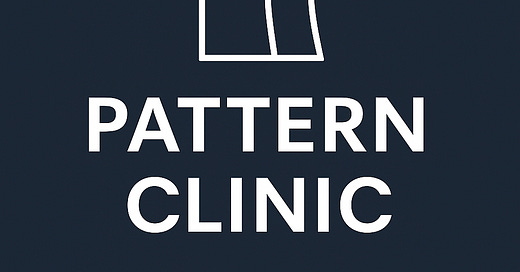You're Just Learning How to Work with Him.
Dear Nuno from 16 years ago,
It’s 6 a.m.
You drink a glass of water and tie your shoelaces.
Today is your first day.
Your first step as a pattern maker.
On the crowded subway, surrounded by strangers,
you feel nervous — and strangely excited.
Before you left the house, you opened the curtain.
It didn’t fall quite right, so you pulled it again. And again.
You didn’t know it then, but that was your first draping practice.
You probably thought you created that beautiful drape.
But here’s the truth:
You didn’t.
Gravity did.
If there’s one thing I wish I could’ve told you on day one,
it’s this:
You’re not designing alone.
You’re working with gravity.
You majored in physics, so this should make sense.
All you really did was arrange the fabric.
You adjusted the tension, set the anchor points.
And nature — gravity — did the rest.
I used to think the same thing:
“I made this beautiful drape.”
But it took me years to realize that gravity is the silent partner
behind every great fit.
You just didn’t know how to work with him yet.
What I want you to understand today:
Why gravity is the hidden hero of great fit
Why shoulder slopes and waistbands are structural, not stylistic decisions
And how understanding this will make you a better pattern maker — faster
If you're reading this as a beginner:
You’re probably adjusting darts, smoothing wrinkles, fixing silhouettes.
(I was too — I still am. Learning never ends.)
But here’s the trap:
If you don’t understand how gravity pulls from structural anchor points,
your fixes will always fail.
Gravity isn’t background noise.
We live in it.
We wear clothes in it.
We design in it.
And it never stops working.
It’s your quiet collaborator.
It doesn’t speak.
But it defines every line of fit.
It decides how fabric falls, stretches, folds, and clings.
Without gravity, you wouldn’t one day watch your future wife
walk down the aisle in a beautifully draped gown.
She’d just be wearing a mess of fabric.
(Don't worry. That didn’t happen.)
Example 1: Tops Begin at the Shoulder
The shoulder is the anchor that holds a top up.
That’s where gravity starts doing its work.
If the slope is too steep: the neckline lifts, the center collapses.
If it’s too flat: the armholes drop, and the side seams crumble.
How well you understand this
will define the structure of the entire upper body.
We’ll dive deeper into this in a later letter.
Example 2: Bottoms Begin at the Waistband
It’s not the hips that hold things up — it’s the waistband.
That’s your structural anchor.
Many designers don’t think twice about its shape or position.
But:
A low-rise, straight waistband? The front collapses.
A high-rise, curved one? The back center warps, and the hips distort.
Most fit issues begin here.
Fixing what you see without rethinking the structure
will just keep the problems coming back.
It takes more courage to redesign than to tweak.
Fit isn’t luck.
It’s structural design.
(We’ll explore that more, too.)
But for now, just remember:
This isn’t just about gravity.
It’s about the moment I always wanted to tell you this truth.
You may not realize it yet —
but you’re already reacting to gravity.
You’ve made beautiful drapes before, right?
That means part of you already knows.
The logic is simple.
But finding the exact anchor point is not.
Gravity pulls everything toward the earth.
Patterns exist to resist that pull and hold shape.
It all starts with the right anchor: shoulders. Waistbands.
Design these right, and you’ll spend less time chasing wrinkles
that just won’t go away.
Not all of them — but enough to feel the shift.
Before you draft your next pattern, ask yourself:
What is the anchor point resisting gravity in this design?
Is that anchor stable? (Shoulder slope, waistband angle)
Am I designing flow from top to bottom?
Have I tested it — on a body or in 3D?
Am I fixing symptoms, or redesigning the source?
That’s it for today.
This isn’t just a tip.
It’s a declaration.
Understanding unseen forces is real skill.
You don’t have to control gravity.
Just respect it.
That’s where real pattern making begins.
Congrats on your first day.
I’ll write again in two weeks.
— Nuno, 16 years later
👉 Small beginnings create big changes. Let’s grow together.



